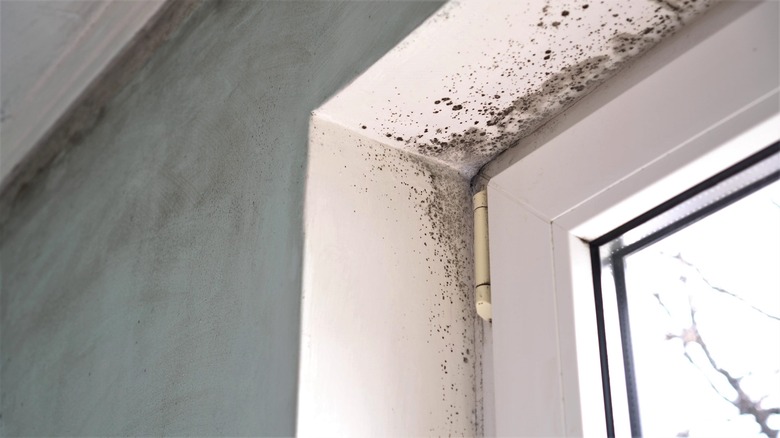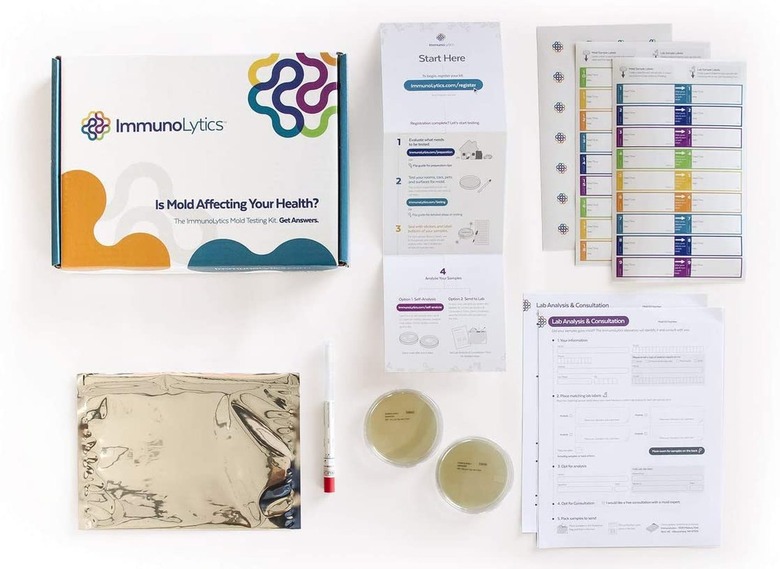A DIY Guide To Home Mold Test Kits
We may receive a commission on purchases made from links.
If you're worried you might have mold in your home, it's easy to find a mold test kit, but there are two things you should know. The first is that a home test kit can detect the presence of mold, but most of them can't tell you what kind it is; you have to send a sample to a lab for that. The second is that since there are some 100,000 mold species in the world, it would be unusual if the test kit didn't detect some type of mold. So, don't panic if the mold test kit delivers positive results for mold — because what kind of mold it is matters, and while some species are harmful, many aren't.
There is also a difference between mold you can see or smell and mold you can't. If you can see mold growth on the bathroom walls or you can smell mold in the bathroom, neither the EPA nor the CDC recommends testing to see what kind it is. They recommend treating all visible mold and mildew growth equally and cleaning it up with soap, water and sometimes bleach. On the other hand, testing can alert you to an invisible mold problem that could have an adverse effect on your home's indoor air quality. If lab results indicate the presence of harmful species, you may need a mold inspection to pinpoint the source and help you with mold remediation.
How a Mold Test Kit Works
How a Mold Test Kit Works
You can buy a DIY mold testing kit that can detect surface mold or one that detects mold in the air (some kits do both) at any hardware store or from an online retailer. Kits that test for surface mold often contain a swab or some other means for collecting samples, and most require you to deposit the collection apparatus along with the sample in a sealed bag and mail it to the lab associated with the product. The bag is included along with a preaddressed envelope, and lab testing typically costs from $15 to $40. Lab fees aren't always included with the purchase price; in fact, there are usually additional fees for lab analysis. One exception is the Healthful Home test kit that includes supplies for testing specifically for Stachybotrys (black toxic mold) and for potentially hazardous Aspergillus and Penicillus.
Kits designed to test for mold in the air come with some type of device to collect air samples. It may be an air sampling pump or a petri dish with a growing medium that you leave exposed to the air for a prescribed time. Every kit is a little different, so it's important to read the instructions that come with the kit you choose and follow them exactly. Once you have your sample, you bag it and mail it to the lab, and you get results either through the manufacturer's website or by mail. Sometimes, lab analysis results are available within five to seven days, but for some kits, you may have to wait as long as eight weeks.
Test kits with petri dishes provide visual confirmation of the presence of mold because you can see it growing, but you still need lab analysis to find out what kind it is. It could be something as innocuous as Rhizopus stolonifer, a common and more or less harmless type of bread mold, but it could also be Cladosporium, a different type of bread mold that is more hazardous. Chances are you'll see some kind of mold since spores are everywhere, so a petri dish test isn't always conclusive, and a positive result should usually be followed up with a mold inspection.
Where to Test for Mold
Where to Test for Mold
Mold spores are everywhere, both indoors and outdoors, and people breathe them in constantly, usually without any ill effects. A mold problem develops only when the spores land on a surface and grow into a colony, and for that, they need moisture. The best places for homeowners to find mold and mildew, therefore, are those that are chronically wet, and of course water is common in the bathrooms, kitchen and laundry room, so they are good places to test. There are a few other likely places, some of which you might not expect:
- Behind the toilet tank and behind sofas, chairs and bookcases that don't get moved very often.
- In corners of rooms with poor ventilation and little light, such as dens, hallways and especially basements.
- Around the edges of ventilation ducts and inside them.
- Inside air conditioner drain pans and drainage tubing.
- Around windows that frost up in the winter and where condensation is visible.
- Near baseboards in front of walls containing plumbing pipes.
- Underneath piles of cardboard or clothing and inside rolled-up carpeting stored in the basement.
Mold and mildew can grow virtually anywhere they have a steady supply of moisture, which may be from a leaking plumbing pipe, water damage, high humidity or steady vapor or condensation from the air. As a general rule, if you can smell mold, it's probably there, and if you can't see it, a surface or air test will confirm its presence.
Testing for Peace of Mind
Testing for Peace of Mind
You're right to be concerned about mold in your home because several types of mold can be harmful. Some species are allergenic, causing allergic reactions and asthma; some are pathogenic, causing illness in people with compromised immune systems; and some are toxigenic, causing severe health problems in otherwise healthy people. The number one strain for which to be on the lookout is Stachybotrys, the infamous black toxic mold, which loves to grow on wood framing and drywall. Many less harmful molds look similar, so you can't assume that black mold on the wall or under the sink is Stachybotrys, but it could be Aspergillus or Aureobasidium pullulans, which are also harmful.
If you see mold inside the air conditioner, it's definitely important to test it because it could be Acremonium, a group of toxigenic strains that can cause breathing problems and pneumonia. This type of mold can be different colors, including white, pink and gray, and testing is the only way to positively identify it. Because of the danger of having it broadcast through the air by the air conditioner blower, you should have a mold removal inspector check out your air conditioner and clean it. Although some kits, such as the Mold Armor home mold test kit, are specifically designed for do-it-yourself testing of air conditioning and heating systems, cleaning an air conditioner is a job for a pro, so if you see mold, you might as well have the pro inspect it as well as clean it instead of doing the testing yourself.
As a general rule, if you can see mold growing, you should clean it. A home mold test kit is most useful for detecting mold that you can't see, whether it's on a surface or in the air, and remember that you usually need a lab test to identify the mold type. Mold and mildew are unsightly, which is reason enough to undertake a home improvement program to control it, but even if a lab analysis reveals only a benign strain, conditions are ripe for another more harmful strain to grow in the future. The best strategy to control mold is to eliminate moisture by improving air circulation using a dehumidifier or by physically wiping surfaces dry with a rag.

